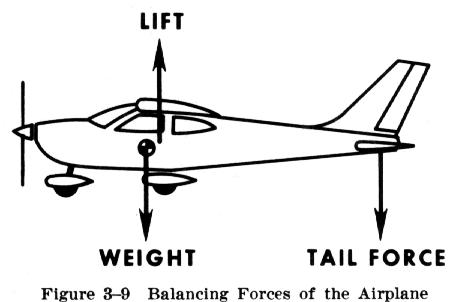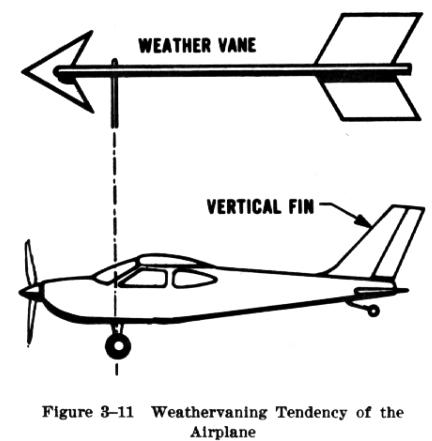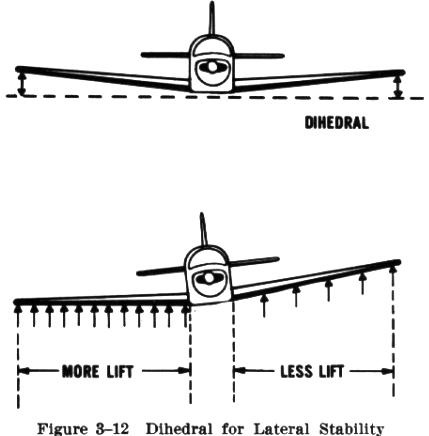Stability
Stability and Controllability
| Besides being supported in flight by lift and propelled
through the air by thrust, an airplane must be stable and controllable
since it is free to revolve or move around three axes. These axes may be
thought of as axles around which the airplane revolves, much like a wheel
does. Each axis is perpendicular to the other two and all three intersect
at the airplane's center of gravity (CG). The point around which the airplane's
weight is evenly distributed or balanced is considered the CG of the airplane.
The axis which extends lengthwise through the fuselage from the nose
to the tail is the longitudinal axis. The axis extending through the fuselage
from wingtip to wingtip is the lateral axis. The axis which passes vertically
through the fuselage at the center of gravity is the vertical axis (Fig.
3-8).
Rotation about the airplane's longitudinal axis is roll, rotation about
its lateral axis is pitch, and rotation about its vertical axis is yaw. |
|
Because of their ability to revolve about these axes, all
airplanes must possess stability in varying degrees for safety and ease
of operation. An unstable airplane would require that the pilot continually
vary pressures on the flight controls and consequently would be difficult
to control. The term "stability" means the ability of the airplane to return
of its own accord to its original condition of flight, or the normal flight
attitude, after it has been disturbed by some outside force. A ball in
a round bowl is considered stable because after being pushed to one side
it will roll back and forth until it finally comes to rest at the center
of the bowl.
If an arrow having no feathered tail is shot from a bow,
it usually will wobble or fall end over end as it travels, since there
is no force produced to bring it back to its original point first travel.
The arrow is made stable, however, by adding pieces of feather near the
rear of its shaft. Then, when the arrow is shot and begins to wobble, turn,
or yaw, the air strikes the tail feathers at an angle and deflects the
feather end of the shaft to turn the arrow back to a straight path. This
corrective action continues as long as the arrow has sufficient forward
motion.
An airplane wing by itself is also unstable. It would flip
over and continue to flip end over end as it flutters to the ground. Like
the unstable arrow, the unstable wing needs some kind of "tail feathers"
to balance it and keep it on a straight course. Like the stable arrow,
airplanes have their "tail feathers" in the form of horizontal and vertical
surfaces located at the rear of the fuselage. These surfaces are the horizontal
stabilizer and the vertical stabilizer or fin.
If all the upward lift forces on the wing were concentrated in one
place, there would be established a center of lift, which is usually called
center of pressure (CP). In addition, if all the weight of the airplane
were concentrated in one place, there would
| be a center of weight, or as it is termed, center of gravity
(CG). Rarely, though, are the CP and the CG located at the same point.
The locations of these centers in relation to each other have a significant
effect on the stability of the airplane. If the center of the wing's lifting
force (CP) is forward of the airplane's center of gravity (CG) - the airplane
would always have a tendency to nose up and would have an inherent tendency
to enter a stalled condition. Therefore, most airplanes are designed to
have their CG located slightly forward of the CP, to create a nose down
tendency so the airplane will have a natural tendency to pitch downward
away from a stalling condition (Fig. 3-9). This provides a safety feature
in the characteristics of the airplane. |
 |
 |
While the airplane is flying within its range of normal speeds, the
airflow exerts a downward force on the horizontal stabilizer; thus, at
normal cruise speed it partially offsets the inherent nose heaviness of
the airplane. In addition, many airplanes have the line of thrust located
lower than the CG. In this situation the propeller's thrust provides a
nose up pitching force to help overcome the inherent nose heaviness. With
this balanced condition, the airplane characteristically will remain in
level flight. However, when the power is reduced and the airspeed is decreased,
the airflow exerts less downward force on the horizontal stabilizer. At
the same time the nose up force of thrust is also decreased (Fig. 3-10).
Due to this unbalanced condition the airplane's nose will tend to lower
and the airplane will enter a descent of its own accord.
During the descent the airspeed will begin increasing. As a result,
the downward force increases on the horizontal stabilizer, causing the
nose to rise. This process will continue again and again if the airplane
is dynamically stable (and if the pilot takes no action to stop it), but
with each oscillation the nose up and nose down motion becomes less and
less. Eventually, the airplane's descent attitude and airspeed will stabilize. |
| Like the feathered arrow, the most important factor
producing directional stability is the weathervaning effect created by
the fuselage and vertical fin of the airplane (Fig. 3-11). It keeps the
airplane headed into the relative wind. If the airplane yaws, or skids,
the sudden rush of air against the surface of the fuselage and fin quickly
forces the airplane back to its original direction of flight.
Generally, in straight and level flight, the wings on each side of the
airplane have identical angles of attack and are developing the same amount
of lift. This laterally balanced condition normally keeps the airplane
level. Occasionally, though, a gust of air will upset this balance by increasing
the lift on one wing and cause the airplane to roll around its longitudinal
axis. A well designed airplane has certain design features to counteract
this momentary unbalanced condition and return the airplane to a wings
level attitude. |
 |
 |
Most airplanes are designed so that the outer tips of the wings are
higher than the wing roots attached to the fuselage. The upward angle thus
formed by the wings is called the dihedral, and is usually only a few degrees
(Fig. 3-12).
The rolling action of an airplane caused by gusts is constantly
being corrected by the dihedral of the wings. If one wing gets lower than
the other when the airplane is flying straight, it will have a different
attitude in relation to the oncoming air. The result is that the lowered
wing has a greater angle of attack and thus more lift than the raised wing
and consequently will rise.
If this rising action causes the wing to go past the level attitude,
the opposite wing will then have a greater angle of attack and more lift.
A dynamically stable airplane will oscillate less and less and eventually
will return to its original position as the oscillation dampens.
Although stability in an airplane is desirable, it must
not be so strong that the pilot cannot overcome the inherent stability.
The pilot must be able to control or maneuver the airplane at will about
the airplane's three axes. |
Roll, pitch, and yaw, the motions of an airplane about
its longitudinal, lateral, and vertical axes, are controlled by the three
control surfaces. This will be discussed in the chapter on The Effect and
Use of Controls.




